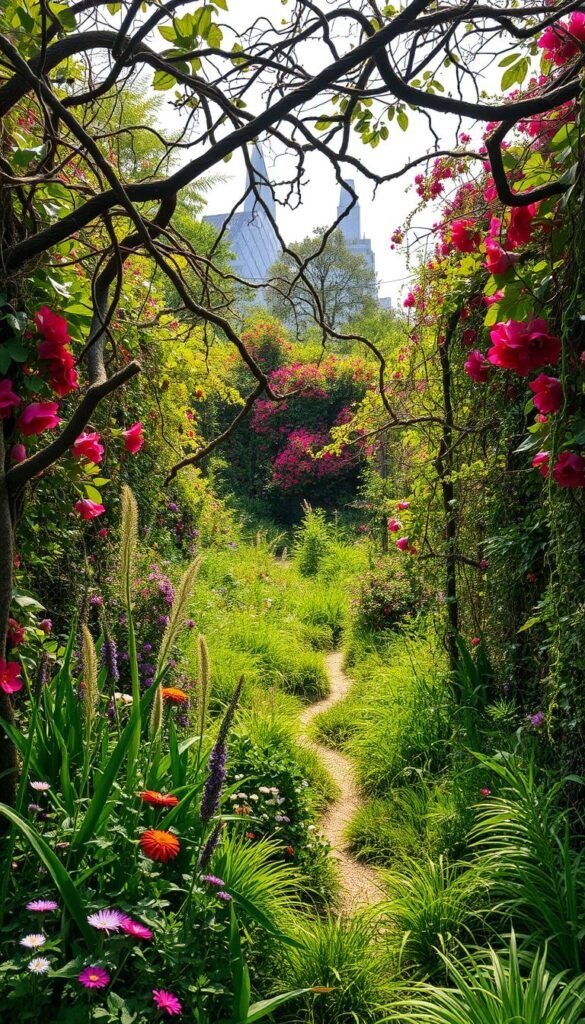Tired of strict garden rules? Chaos gardening offers a fresh take on growing plants. This method lets nature guide the way, creating vibrant, diverse spaces.
Instead of neat rows, your garden becomes a lively mix of flowers, herbs, and veggies. The approach supports biodiversity while reducing maintenance. It’s perfect for those who want beauty with less work.
Popular on TikTok, this trend connects to permaculture principles. Real-world examples show how it boosts harvests and attracts wildlife. Learn more about letting nature lead in your outdoor space.
Whether you have a small patio or large yard, this style adapts easily. It’s not just pretty—it’s practical, sustainable, and full of life.
What Is Chaos Gardening?
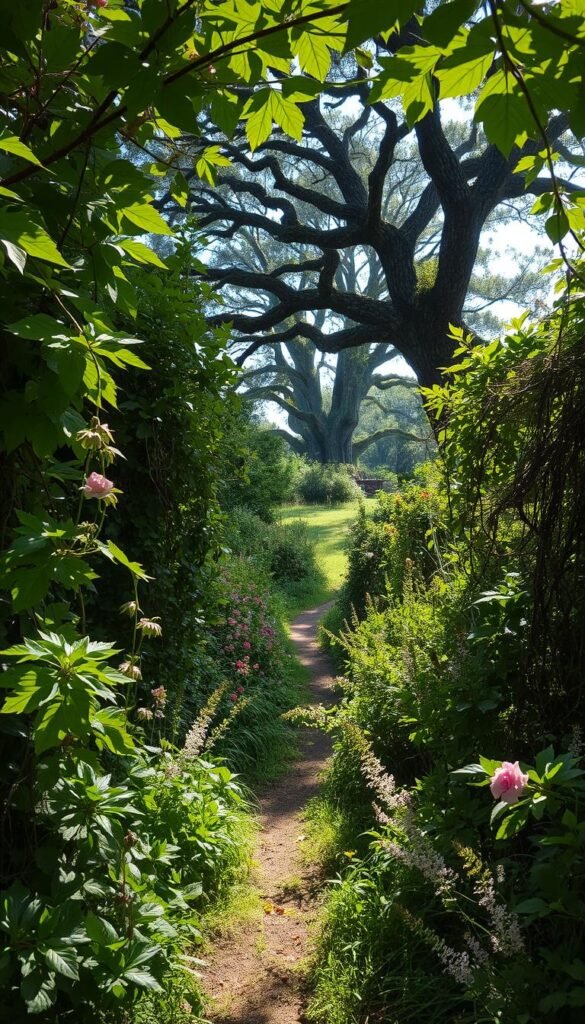
Forget perfect rows—discover a garden style that thrives on spontaneity. Unlike traditional gardens, this approach embraces unpredictability. You scatter seeds freely, letting plants grow where they thrive best.
The Philosophy Behind Letting Nature Lead
Angela Nickerson calls it the “mix-and-scatter” method. There’s no rigid plan—just trust in nature’s wisdom. This mirrors the Japanese philosophy of wabi-sabi, finding beauty in imperfection.
Debbie Wolfe traces its roots to pre-1800s cottage gardens. These spaces mixed flowers, herbs, and veggies without strict design. Today, it’s a rebellion against over-manicured lawns.
How It Differs From Traditional Gardening
Traditional gardens rely on order: straight lines, color coordination, and weed control. Chaos gardening skips all that. Plants mingle freely, creating a lively tapestry.
Even naturalistic design, like Piet Oudolf’s landscapes, requires planning. Here, you embrace surprises—volunteer blooms, uneven growth, and shifting patterns each season.
Why Chaos Gardening Is Gaining Popularity

Why are more people ditching rigid garden plans? The answer lies in a blend of practicality and viral inspiration. This trend celebrates spontaneity, offering a refreshing break from high-maintenance landscapes.
The Appeal of Low-Effort Landscaping
The pandemic shifted priorities. Homeowners now crave outdoor space that’s easy to manage. Chaos gardening delivers—no weeding, no strict layouts, just vibrant growth.
Linda Vater, a gardening expert, suggests pairing quick-growing annuals with perennials. This mix ensures staggered blooms with minimal replanting. *Artful guidance* keeps things wild yet intentional.
Angela Nickerson proves its versatility. She uses scattered seeds to protect orchard soil. The result? A living mulch that suppresses weeds naturally.
Social Media’s Role in the Trend
TikTok turned chaos gardening into a sensation. Videos like @meggrowsplants’ 2M-view tour showcase squash vines erupting from compost piles. These clips make failed experiments feel like wins.
Over 8,000 videos tag #chaosgardening, revealing sunflowers tangled with tomatoes. The platform democratizes the craft—no expertise needed, just curiosity.
Prefer structure? Explore structured vs. wild gardens to find your style. Either way, the joy is in the journey.
The Benefits of Chaos Gardening
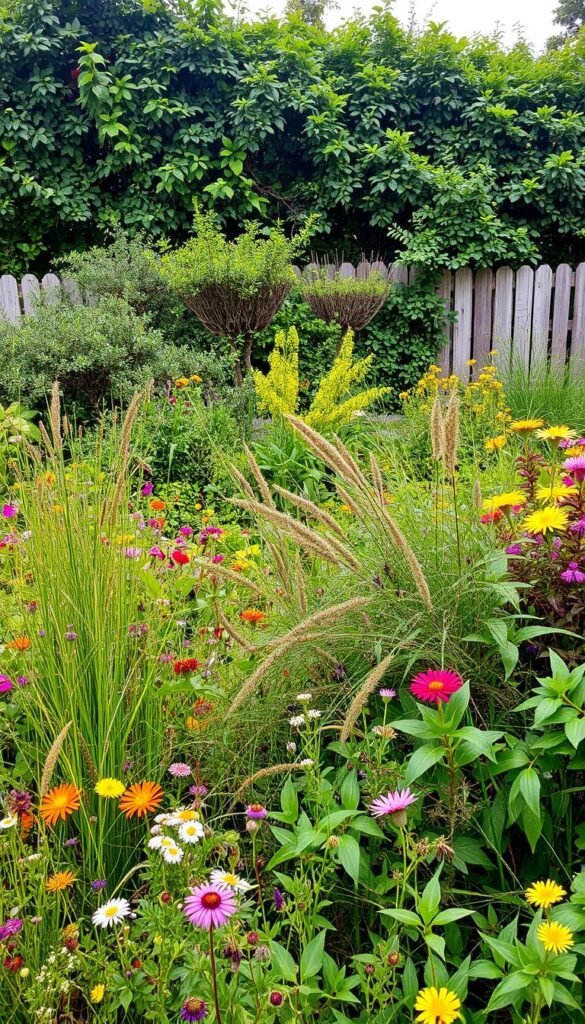
What if your outdoor space could thrive with minimal effort? This untamed approach delivers more than just beauty—it supports the planet while saving you time.
Boosting Biodiversity in Your Backyard
Mixed plant heights create microhabitats for bees, birds, and butterflies. Clover and daikon radishes improve soil health naturally, eliminating the need chemical fertilizers.
Doug Tallamy’s research shows native plants attract 4x more pollinators. The National Wildlife Federation found they also host caterpillars, a vital food source for chicks.
Reducing Maintenance and Water Use
Dense planting acts like living mulch, suppressing weeds and retaining moisture. Angela Nickerson’s orchard saved 30% on watering using this method.
- EPA data shows mulched gardens use 20–30% less water.
- Self-seeding flowers like calendula return yearly, cutting replanting work.
Creating a Resilient Garden Ecosystem
Chaos gardens mimic nature’s layers, from ground covers to tall sunflowers. This diversity strengthens your local ecosystem, making it pest-resistant.
Native plants adapt to weather extremes, reducing losses during droughts. Your yard becomes a sanctuary where life thrives—effortlessly.
Common Misconceptions About Chaos Gardening
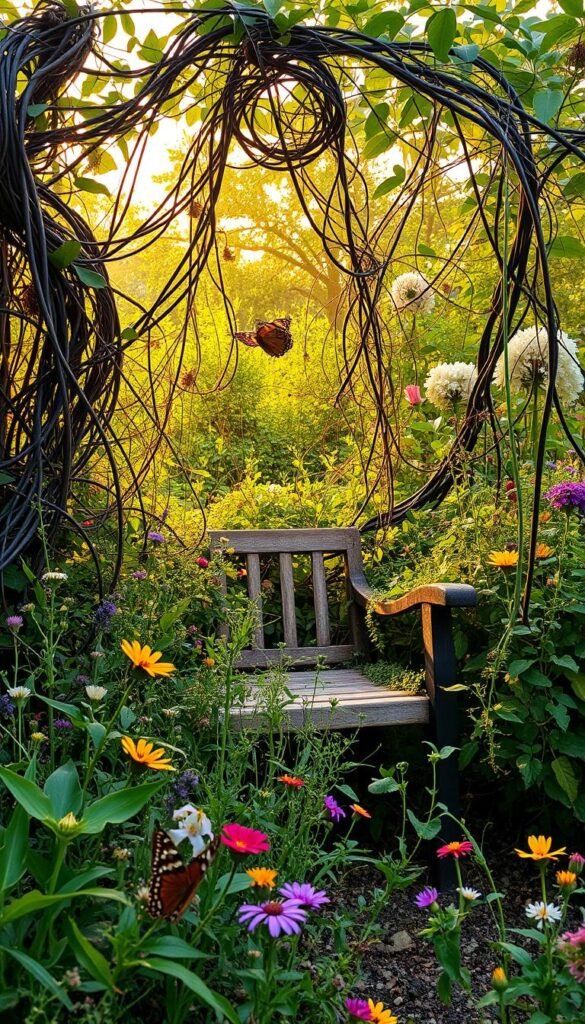
Ever heard that wild growth equals no effort? Think again. This style is often misunderstood as careless, but it thrives on smart practices, not neglect.
It’s Not Just Neglect or Laziness
Angela Nickerson proves this with her burlap soil-prep technique. She layers compost under burlap to suppress weeds—hardly a lazy approach. Strategic care ensures thriving plants without rigid rows.
Mary Reynolds’ rewilding projects show similar intent. Her landscapes blend native species with artistic structure, proving wild doesn’t mean unplanned.
Chaos vs. Naturalistic Design
Piet Oudolf’s meadows look untamed but involve meticulous design. Chaos gardening skips that planning, letting seeds fall where they may. The difference? One curates, the other celebrates surprises.
Avoid tourist-trap seed tins with mismatched mixes. Research germination times and avoid invasive species. Even wild spaces need knowledge.
- Add subtle structure: Debbie Wolfe suggests birdbaths or stepping stones to anchor the wildness.
- Prioritize native plants: They adapt better and support local wildlife.
How to Start Your Chaos Garden: A Step-by-Step Guide
Ready to break free from rigid planting rules? Your wild garden adventure starts here. Whether you’re working with a sunny backyard or a shady balcony corner, these steps will help you create chaos garden spaces that thrive with minimal fuss.
Choosing the Right Location
Not all spots are equal. Observe your space for a week—note sunlight patterns, wind exposure, and drainage. Sunny areas suit zinnias and cosmos, while shady nooks favor forget-me-nots and violets.
Debbie Wolfe recommends matching seed mixes to microclimates. “A dry, rocky spot needs drought-tolerant species,” she says. Avoid low-lying areas where water pools, as soggy soil drowns roots.
Preparing the Soil for Wild Growth
Skip the tilling. Angela Nickerson’s burlap method layers compost under biodegradable fabric to suppress weeds. For quicker starts, Debbie Wolfe suggests light raking to loosen the topsoil.
- Soil health first: Test pH and amend with organic matter if needed.
- Leave some bare patches for self-sowing plants to colonize naturally.
Selecting the Best Plants and Seeds
Stick to a 75% native, 25% non-native ratio for balance. Angela’s “chaos starter kit” includes borage (pollinator magnet), daikon radishes (soil aerators), and clover (nitrogen fixer).
Beware of tourist-shop seed tins—they often contain invasive species. Instead, source regionally adapted seeds from trusted suppliers like American Meadows. Warm-weather blooms like cosmos need conditions above 60°F to sprout reliably.
Now you’re set to create chaos garden magic. Scatter, step back, and let nature paint the canvas.
Essential Plants for a Thriving Chaos Garden
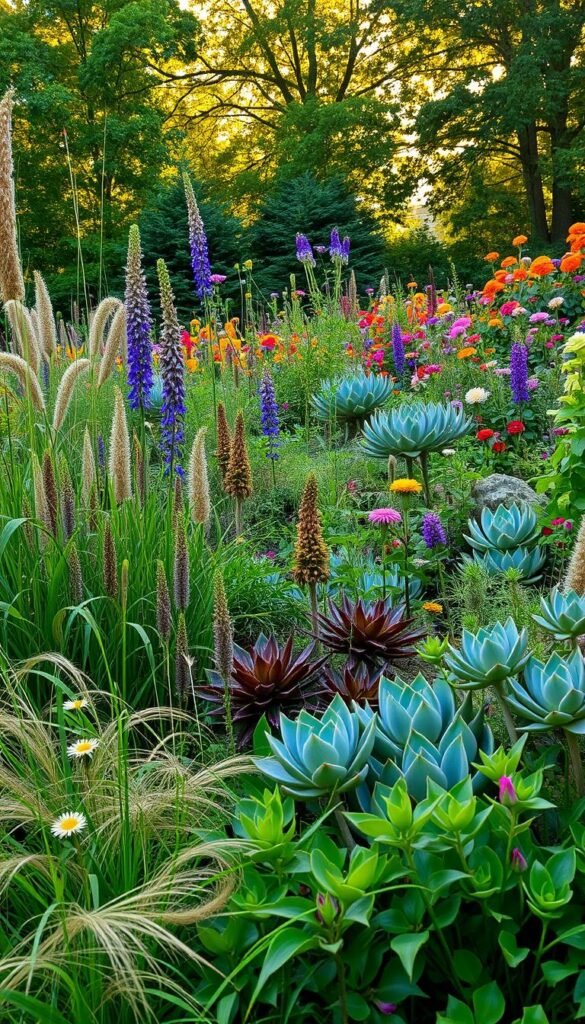
Transform your outdoor space with plants that work together effortlessly. The right mix attracts pollinators, deters pests, and blooms year after year. Focus on native plants, self-seeders, and smart pairings to create a low-maintenance paradise.
Native Species That Support Wildlife
Local wildlife thrives when you plant species they evolved with. Milkweed is a monarch butterfly magnet, while goldenrod feeds bees and beetles. Doug Tallamy’s research shows these native plants host 4x more beneficial insects than non-natives.
Avoid aggressive spreaders like mint. Instead, try these wildlife-friendly picks:
- Sunflowers: Feed birds and attract hover-flies.
- Yarrow: Lures ladybugs to control aphids.
- Purple coneflower: Supports bees and goldfinches.
Self-Seeding Annuals for Surprise Blooms
Let nature replant for you. Nasturtiums pop up yearly, their peppery leaves edible in salads. Calendula’s bright petals soothe skin and reseed freely. Angela Nickerson swears by “cut-and-come-again” lettuces—harvest leaves, and they regrow.
For a balanced spread, try this seed ratio:
| Plant Type | Seed Ratio | Purpose |
|---|---|---|
| Flowers | 3 parts | Attract pollinators |
| Greens | 1 part | Edible variety |
Companion Planting for Natural Pest Control
Some plants are better together. Marigolds repel nematodes near tomatoes, while basil improves pepper flavor. For eco-friendly pest control, pair chives with peppers to deter aphids.
Try these proven duos:
- Dill + cucumbers: Lures predatory wasps.
- Sunflowers + squash: Shades soil and deters beetles.
- Mint + cabbage: Confuses cabbage moths.
Learn more about balancing pests naturally in small spaces.
Overcoming Challenges in Chaos Gardening
Every garden has its hurdles, but wild spaces bring unique rewards. While this style cuts maintenance, some challenges chaos gardening throws your way need smart fixes. From aggressive weeds to thuggish plants, here’s how to keep the wildness thriving—without chaos becoming a mess.
Managing Overgrowth and Weeds
Dense planting suppresses weeds, but some still sneak in. Angela Nickerson’s orchard trick? Underplant with clover—it crowds out invaders while fixing nitrogen. For stubborn patches, a Hori-Hori knife lets you weed precisely without disturbing nearby plants.
Watch for early takeover signs like kudzu or garlic mustard. Yank them before they seed. Pro tip: Mulch paths with wood chips to block weed growth while letting desired plants self-sow freely.
Balancing Plant Competition
Sunflowers might overshadow lettuce, but balance is key. Thin seedlings when they’re 3 inches tall, leaving the strongest. Penn State’s soil tests help adjust nutrients if heavy feeders like corn struggle.
- Sacrificial crops: Plant radishes to absorb excess nitrogen, then chop them as green mulch.
- Succession planting: Swap spent plants with quick growers like arugula to keep space productive.
Dealing with Invasive Species
Not all volunteers are welcome. USDA guidelines flag plants like Japanese knotweed—remove them immediately. Replace with natives like milkweed or coneflower that support wildlife without spreading aggressively.
“Prevention beats cure. Research seed mixes to avoid invasive hitchhikers.”
For persistent invasive species, smother them with cardboard and compost. It’s a time-saver versus endless digging.
Real-Life Chaos Gardens to Inspire You
From urban lots to historic estates, wild spaces are transforming the way we grow. These living labs prove that beauty and biodiversity thrive when we loosen control. Whether you have the right backyard or just a balcony, their stories spark ideas.
Success Stories From Experienced Gardeners
Angela Nickerson’s orchard evolved dramatically over three seasons. By year two, daikon radishes had aerated compacted soil, while clover patches hosted pollinator parties. “The ecosystem balanced itself,” she notes. “Japanese beetles vanished when wild bergamot attracted predatory wasps.”
Berlin’s Prinzessinnengarten shows urban potential. This community plot mixes cornflowers with kale, creating a mosaic that feeds both people and butterflies. Their secret? Annual “seed bombing” events where locals toss native wildflower mixes into neglected corners.
Lessons Learned From Failed Experiments
A Texas gardener’s morning glory takeover serves as cautionary tale. The vines smothered tomatoes within weeks. USDA experts confirm: “Non-native climbers often outcompete food crops.” Their solution? Planting native trumpet vine instead—it hums with hummingbirds but stays manageable.
The Royal Horticultural Society suggests subtle structure:
- Use curved paths to guide exploration
- Group tall plants like sunflowers to create “walls”
- Leave sunny patches for self-sowing annuals
“Chaos isn’t about abandonment—it’s strategic observation.”
See this philosophy in action at Sissinghurst Castle. Their famous “Cottage Garden” section looks delightfully haphazard, yet every plant serves a purpose, from foxgloves feeding bumblebees to comfrey leaves enriching compost.
Embrace the Joy of a Wild and Free Garden
Let your outdoor area become a lively sanctuary where nature takes the lead. Angela Nickerson’s philosophy shines here—gardening becomes joyful when you participate without rigid rules. Start small with a corner patch, then watch it evolve.
Next steps? Test your soil and join communities like Wild Revival. Share your progress with #ChaosGardenWin. Birds might even help by dropping seeds—embrace those happy accidents.
This approach isn’t just about plants. It’s a celebration of life’s spontaneity. Your garden becomes a haven for wildlife, buzzing with bees and fluttering with butterflies. For more inspiration, explore wild beauty ideas or creative outdoor designs.
Now, step back. Let the cardinals decorate with zinnias. Your wild paradise awaits.

